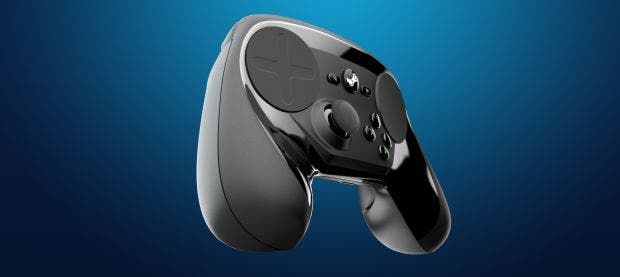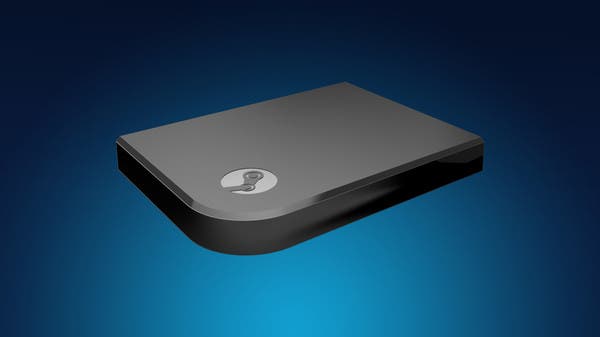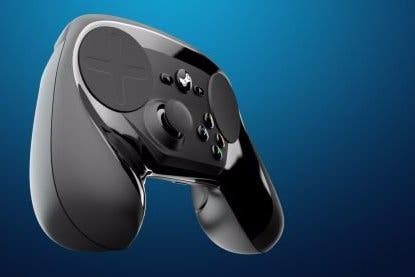Valve's missing Link
How the final Steam Controller and Link firm up Valve's play for the living room.
It feels like a lifetime ago when the Steam Machines made their public debut in Las Vegas in January last year - an event that passed without making much of an indent in the memory, thanks to how underwhelming the initial reveal was. If this was Valve's serious play for the living room, it lacked spark and there was little in the way of substance - though, as our dearly departed Tom pointed out at the time, Valve was playing a longer game.
Cut forward to March 2015, after a delay in the launch of the Steam Machines from a Valve that was surely aware of the apathy that met the assortment of hardware, and that plan is beginning to click into place. As I'm ushered into a quiet, airy booth by Valve's Erik Wolpaw, two of those Steam Machines first glimpsed at CES 2014 sit under imposingly large TV screens - the kind you'd have in your living room, if you had a generous enough budget. But it's two other devices that make Valve's arrival in the living room not only a reality but, for many of us, something of an inevitability.
First those Steam Machines, though. Familiar from last year's reveal, the two models have been selected for display from the 12 or so that will launch this November, demonstrating the range available. First up is the Alienware machine, this particular unit with an i3 processor that's capable of running Croteam's The Talos Principle at 1080p60. On the other end of the scale is a Falcon Northwest that, depending on your configuration, is going to cost between $2000 and $5000. Its excessive power is put to use as it runs Epic's new Unreal Tournament at 60fps on a 4K screen.
Impressive stuff, though I'm still not entirely convinced of the need for another expensive box under the television, even taking into account the vast breadth of the Steam library they make available. What binds them both together is the Steam Controller - now being shown in its final form. There have been a handful of iterations of the controller, and the end result that's shipping this November seems to have found the perfect combination of the form factor seen in traditional console pads and the more modular demands of PC gaming. What's best, though, is how it combines some of Valve's smart new inputs - those delicious haptic pads, for example - with lessons from some of the finest controllers of the past.

Which is why it's the triggers that leave me the most impressed. Not that they do anything new, but in how they replicate one of the best analogue triggers ever to have graced a controller - pull down on each of them, and after a well-judged amount of travel there's a little final click into place, a feature seen and then seemingly forgotten on Nintendo's ageing yet still brilliant GameCube pad. For a dyed-in-the-wool console gamer like myself, it's that kind of detail that makes me eagerly anticipate diving into Valve's new ecosystem.
Valve's clearly got an eye for a similar audience in one of the biggest additions to its controller since we last saw it, the single analogue stick that's placed to the left of the pad. There's a little convex bubble at the centre, surrounded by a ring of ridges on the outer edge to stop your thumb from slipping, and it's the perfect gateway for players new to PC gaming - Valve says console players tend to stick with them for a while before graduating to both trackpads.
Those trackpads are a minor revelation, both in their adaptability and in their feel and feedback. Playing The Talos Principle, the right trackpad is set up like a trackball. There's a heightened sense of analogue control enabled - flick across at speed and it's like sending a trackball spinning, the sensation sold to you by the haptic feedback enabled by the mini actuators under the thin skin. Switching to Counter-Strike, the trackpad's set up to replicate a mouse, allowing for a deftness in movement not possible with a traditional analogue stick.
The force feedback witnessed in console controllers is also enhanced - there are numerous possibilities, such as directional feedback on the left pad that corresponds with where you're taking damage from in a first person shooter, or the persistent chug of a machine gun being sent through your right thumb when you're pulling down on the trigger. Combined, they're the kind of forward-thinking innovations that were perhaps absent when Sony and Microsoft rolled out their own new generation of controllers to accompany their new hardware.
There are some reservations about the new controller, although some of that's down to how new and slightly alien it still feels in the hands. The face buttons are a bit too far of a stretch away from the right trackpad, and while the button layout is to all intents and purposes similar to that of other consoles - there are four face buttons and four shoulder buttons - the two additional buttons that can be found on the back of the pad where your ring finger grips add further wrinkles to a control standard that was already getting congested.

What's there is eminently customisable, though, with a simple, easy-to-access menu allowing you to rebind controls and adjust the sensitivity. As a catch-all for the vast Steam library, it's a surprisingly comprehensive solution - and while it'll take a little more time in its company to fully stand by any such claims, this could well be the best game controller available when it comes out in November.
It's the controller, then, rather than the machines, that feels like the more convincing front of Valve's attempt to embed itself under the television - and it's helped no end by the introduction of Steam Link, the simple and (this is likely the most important part) affordable box that allows you to stream from your home PC to the living room TV.
The box itself is small and unassuming - it's about half the length of a magazine, and around twice as thick - and, unlike the bulk of the Steam Machines already announced, it's aesthetically pleasing. Valve has already proven the potential of its in-home streaming technology, so it's no surprise to see it acquit itself so well - even if it does do so here in a controlled environment, and over a wired ethernet connection - as it plays Shadow of Mordor at 1080p60 with nothing in the way of noticeable compression, nor in input latency.
What sells it, though, is the ease of use. It's effectively plug-and-play, asking for only an HDMI port and very little in the way of space. This is the box that can open up the world of PC gaming, in all of its variety, its breadth and its flair for customisation, in a living room as it effectively and easily funnels the power of a desktop onto the expanded real-estate of a 42-inch TV. The Steam Machines are an interesting offshoot of Steam's coming offensive, then, but it's the unison of Steam Link and the final Steam controller that is Valve's strongest play.









